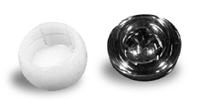


Bristol Knee Clinic

| + home | |
| + news | |
| + research | |
| + patient information | |
| + the clinic | |
| + the surgeon | |
| + sport physiotherapy | |
| + sports advice | |
| + medico legal | |
| + products | |
| + resources | |
| + contact | |
| + maps | |
| + directions | |
| + site map |
The Bristol Knee Clinic |
Hip Resurfacing - The procedure
Aims of Hip Resurfacing
Patients requiring hip surgery today are younger and more demanding. Patients expect an implant that gives them full function allowing them to continue their routine activities. They want the best function from an implant that will last as long as possible.
The history of resurfacing
Various metals have been used in different prostheses since the 1920s. Failure of the first hip resurfacing joints in the 1970s is attributed to the use of the wrong materials. Loosening of the components caused by poor manufacturing tolerances was also a contributing factor. The 1990s saw a change in the materials used with metal-on-metal bearings and the results have been much more encouraging.

A Wagner type of early resurfacing hip replacement using metal on polyethylene.
The advantages of hip resurfacing include:
• reduced dislocation
• restoration of "normal anatomy"
• anatomical loading of the hip joint
• preservation of the patient's natural bone
Further benefits are increased range in motion and greater function of the hip. Hip resurfacing offers patients a very hard-wearing and long lasting implant that is well suited for more active lifestyles.
The risks
In addition to similar risks of a total hip replacement, a resurfacing replacement may fail due to fracture of the femoral neck or avascular necrosis (softening of the bone). Revision of a resurfacing implant is comparatively simple as it can be converted to primary total hip procedure.
The procedure
Similar to a traditional total hip replacement from the surgeon's perspective the head is not removed in a resurfacing procedure but with the use of special equipment it is precisely remodelled to hold the resurfacing implant.
A metal ball is attached to the head with cement, the socket (acetabulum) is prepared, similar to a total hip replacement, with a metal shell being firmly fitted into the acetabular bone. The bone will then grow into the metal shell to hold it in place.
The advantages
The advantages of articular surface replacement include reduced dislocation, restoration of "normal anatomy", anatomical loading of the hip joint and preservation of the patient's natural bone. There is a benefit from increased range in motion and superior restoration of joint function. By utilising the advances in Metal-on-Metal technology the resurfacing procedure offers patients a very durable and long lasting implant that is well suited for higher demand activities and lifestyles.

A radiograph or X-ray of a resurfacing hip replacement.
< BACK to Hip Resurfacing Index | NEXT: Follow-up appointments >
Related Links..
+ How to make an appointment
+ Hip Resurfacing - see all links
+ Patient Information Home
+ See the clinic
+ More about Mr Johnson
+ top
© The Bristol Orthopaedics and Sports Injuries Clinic 2003. The Bristol Knee Clinic is a trading name of the Bristol Orthopaedic Clinic Ltd. privacy / copyright | contact | Powered By Create Medical



